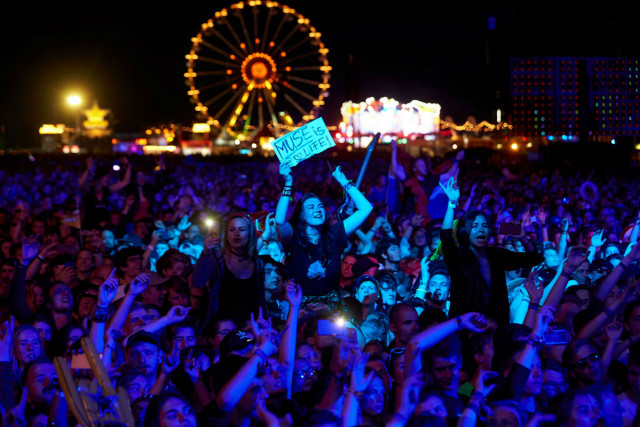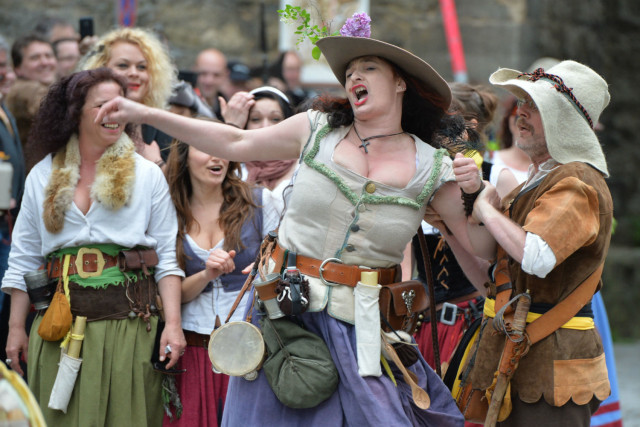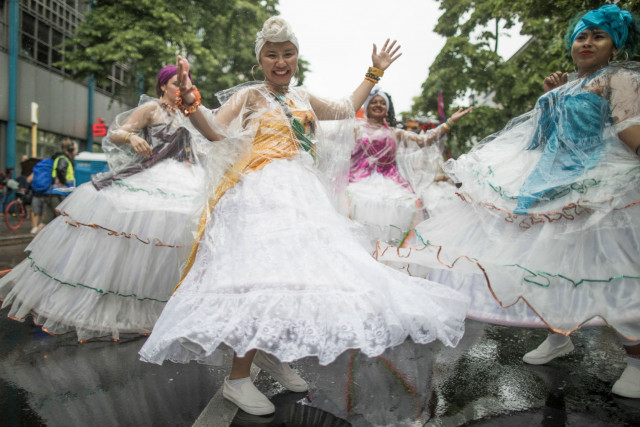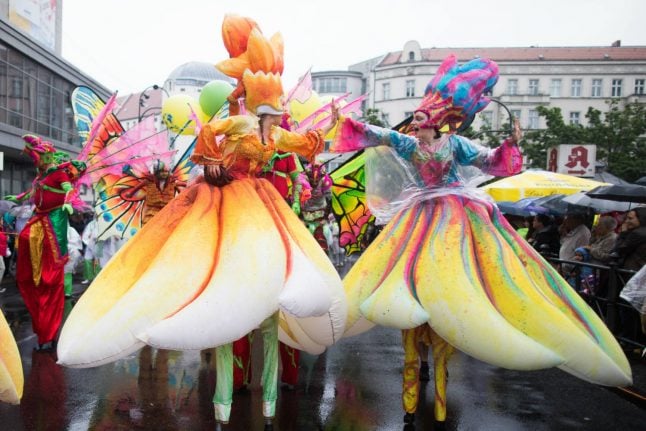Pentecost (or Pfingsten in German) is a a major Christian holiday, and takes place on the seventh Sunday after Easter.
Rock am Ring Festival, Nürburgring, Nürburg, June 7th – June 9th
Nürburg in the southern state of Rhineland-Palatinate, is home to the famous former Grand Prix race course, Nürburgring, as well as the popular Rock am Ring rock music festival.
This weekend’s festival features well-known acts such as The 1975, Architects and Bastille, as well as a multitude of other rock bands. If you find yourself further south, the Rock im Park festival in Nuremberg runs simultaneously with an almost identical lineup.

Concert goers at last year's Rock am Ring festival. Photo: DPA.
Pfingstfestspiele, Baden-Baden, June 7th – June 10th
Less of a rock lover and more of an opera fan? Baden-Baden’s Pfingstfestspiele takes place at the Festspielhaus and features daily performances, with two on the Monday, from both soloists and orchestras.
Originally built as a train station, the stunning venue boasts the claim as Germany’s largest opera house with a capacity of 2,500 and the festival is considered one of the highlights of the performance year. Take advantage of the festival’s location and spend the daytime exploring the Black Forest, or relaxing in Baden-Baden’s thermal baths.
Weindorf Weinfest, Würzburg, May 29th – June 10th
Situated in the famous winegrowing Franconia region in Northern Bavaria, Würzburg’s wine festival started in May and will culminate this weekend. The so-called ‘Wine Village’ (Weindorf) is located in the middle of Würzburg’s market square, where a number of gazebos serve over 100 local wines from around 30 different winemakers. The outstanding wine selection is complemented by a variety of Franconian food.
Leipziger Stadtfest, Leipzig, June 7th – June 9th
Leipzig’s city festival hosts a range of events, including an open-air disco, a night time illumination of the city’s marketplace, and a stage at Augustusplatz with a constant rotation of performances. Nikolaikirchhof will be transformed into an Irish village, with displays of Irish dancing and Guinness on tap.
Meistertrunk Show, Rothenburg, June 7th – June 10th

Actor's in Rothenburg's 2013 Meistertrunk Festival partake in a procession through the city. Photo: DPA.
Rothenburg ob der Tauber is renowned for its preserved medieval façade, and the annual festival re-enacting the plight of the town in 1631 in the light of the Thirty Years War is made only more authentic by Rothenburg’s picturesque backdrop.
The city puts on an impressive range and volume of events over the Pentecost weekend in order to commemorate the its fall following a siege and how it was then saved by its mayor at the time. According to legend, the city mayor managed to drink 3 ¼ litres of wine in one go, impressing General Tilly so much that he decided to spare the city.
The events of 1631 have been re-enacted in the city annually since 1881 and the highlight of the weekend is without a doubt the famed ‘Master Draught’ play, which is performed every evening of the festival.
Hamburg International Short Film Festival, June 4th- June 10th
This year’s International Short Film Festival in Hamburg coincides with the Pentecost weekend and offers film buffs the opportunity to view around 400 short films in international and national competitions. An element unique to the Hamburg Short Film Festival is the ‘Three Minute Quickie’ competition, whereby entrants can submit a film of no more than 3 minutes, to challenge their artistic and creative boundaries.
Rose and Light festival, Frankfurt, June 7th- June 11th
Frankfurt’s Palmengarten, one of Frankfurt’s three botanical gardens, is beautiful on any day of the year, and even more so during the weekend-long Rose and Light festival (Rosen und Lichterfest). The festival starts with the opening of the Rose exhibition on Friday the 7th, but the main event of the weekend is on the Saturday evening, when thousands of tea lights illuminate the roses, and fireworks light up the sky at the end of the evening.
The daytime also features a range of events, including those designed for children and musical performances.
Open Ohr Festival, Mainz, June 7th – June 10th
The ‘Open Ear Festival’ (Open Ohr Festival) in Mainz describes itself as an uncommercial, thematic, youth culture festival for visitors of all ages and has focused on the celebration of youth since its start date in 1975. Taking place in the city’s baroque era citadel, it features four days of music, performances, workshops, discussion forums, cabarets and craftwork.
The ‘Free Project Group’ (die Freie Projektgruppe), who organise the event, choose a controversial theme every year which is then reflected throughout the activities of the festival. This year’s theme is ‘Take Sides’ (Partei ergreifen) and is concerned with politics and increasing active participation in and conversation about democracy.
Handel Festival Halle, May 31st – June 16th
Celebrating Halle-born musical genius George Friedrich Handel, the composer who became well-known for his operas and concertos, this international music festival focuses solely on Handel's music. This year’s festival title is ‘Sensitive, heroic, sublime- Handel’s women,’ and will hone in on both the women in Handel’s life and the women figures in his operas, with leading women musicians taking to the stage to perform Handel’s music. More than 1,000 artists from around the world will partake in a programme of over 100 events in 22 different venues throughout the weekend.
Karneval der Kulturen, Berlin, June 7th – June 10th

A dance group from Berlin's 2017 carnival. Photo: DPA
Berlin’s Karneval der Kulturen (Carnival of Cultures) is an explosive celebration and display of diversity which sprawls across the streets of Kreuzberg over the Pentecost weekend. Dances, parades and floats from a plethora of countries represent Berlin’s diverse city landscape. The festivities originated as a statement against the xenophobic clashes in 1996 and has now grown into an expansive festival which attracts over a million visitors annually.
The carnival starts on Friday at 4:00pm and the weekend’s highlight is generally considered to be the famous street parade which sets off from Yorckstrasse / Großbeerenstrasse at 12:30pm on Sunday.



 Please whitelist us to continue reading.
Please whitelist us to continue reading.
No love for the Berlin Airlift 70 in Wiesbaden? Come on, guys.
https://www.wiesbaden.de/en/living-in-wiesbaden/festivities-markets/festivities/anniversary-berlin-airlift.php